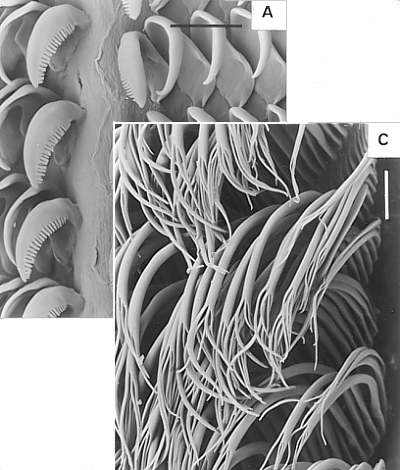
Rostanga orientalis
- Radula
PHOTO
From Figure 23. Rostanga orientalis, radular morphology, AM C151978. A, Central region and inner right lateral teeth; C, outermost right lateral teeth. Scale bar = 30 µm. Photo G.J. Avern. [Rudman, W.B. & Avern, G.J. (1989). The genus Rostanga Bergh, 1879 (Nudibranchia: Dorididae) in the Indo-West Pacific. Zoological Journal of the Linnean Society 96: 281-338.]
Return to Rostanga orientalis
The innermost lateral tooth has an extremely elongate blade with a fringe of approximately 25 short rounded denticles along the whole of the inside edge. There are no outer denticles (Fig A). The inner lateral teeth, from Tooth 2, have a broad base and a recurved narrow pointed, non-denticulate blade similar in length to the innermost tooth. From approximately Tooth 15 the lateral teeth begin to gradually increase in length reaching a maximum at about Tooth 50 where there is a transition zone of two or three teeth before the brush-like outer laterals. The outer laterals have a long slender pointed cusp and a shorter but similarly slender outer denticle attached approximately a third of the way from the tip. Between the cusp and the denticle are two, sometimes three rod-like denticles attached by a common stalk. These secondary denticles are very long reaching to the tip of the tooth (Fig C). In the transition zone between the mid and outer laterals the cusp becomes more slender and there is an elongate outer denticle. There are about three transition teeth in each row before the rod-like secondary denticles begin to appear. The jaw plates are relatively large but there are only about eight rows of tightly packed chitinous rodlets, half of which are covered by a membrane.
The radular formulae of four specimens from Hong Kong are:
36.0.36 x 35 (+ 1) - 6 mm preserved (AM C139197)
67.0.67 x 48 (+ 3) - 19 mm preserved (AM C139143)
73.0.73 x 53 (+ 1) - 22 mm preserved (AM C151978)
81.0.81 x 60 (+ 2) - 27 mm preserved (AM C139144)
Rudman, W.B., 2002 (February 5) Rostanga orientalis - Radula. [In] Sea Slug Forum. Australian Museum, Sydney. Available from http://www.seaslugforum.net/factsheet/rostorierad
